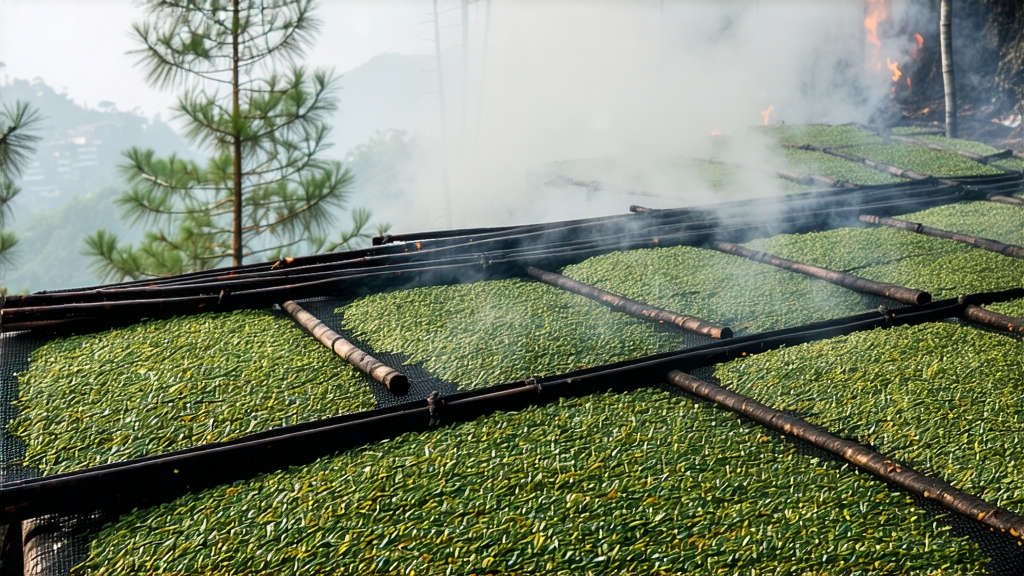
Ask most tea lovers to name the first black tea ever created and they will probably point to India’s Assam or Sri Lanka’s Ceylon. Yet the true progenitor is a small, rugged leaf from China’s Wuyi massif in northern Fujian, a tea that still carries the fragrance of the pine fires on which it was born almost four centuries ago: Lapsang Souchong. Revered in Europe as “bohea,” maligned in modern guidebooks as “too smoky,” and worshipped by a new generation of specialty farmers who craft unsmoked, honey-sweet versions, Lapsang Souchong is the living bridge between Ming-dynasty innovation and contemporary craft tea. To understand it is to understand how China invented black tea, how Europe fell in love with it, and how a single leaf can taste of campfire, longan, cacao and mountain mist all at once.
-
Historical Footprints from the Wuyi Cliffs
Local legend fixes the birth year at 1646, when Qing troops descended on Tongmu Pass and tea workers, forced to flee, hastily dried freshly rolled leaves over fresh pine embers to meet the next day’s market boat. The accidental smoke infusion delighted Dutch traders in Xiamen, who bought every basket and shipped it to Amsterdam as “thee van Bo-hee,” a corruption of the Wuyi range’s name. By 1669 the British East India Company had made bohea its most valuable cargo, outpricing green tea in London auctions and inspiring the word “tea” itself to enter the English lexicon. The Boston Tea Party chests were 342 of bohea; Jane Austen’s characters “took bohea after dinner”; and Russian caravans carried it across Siberia, swapping sable pelts for bricks of smoked leaf pressed against horse flanks. Thus a Fujian village of fewer than 300 households once dictated the morning ritual of half the globe. -
Terroir: Why Only Tongmu Can Birth the Original
UNESCO lists the Wuyi range as a World Heritage biosphere for its vertical micro-climates: 96 % humidity before dawn, 28 °C at noon, mineral-rich laterite washed by monsoon streams. The original cultivar is xiao zhong qi zhong, a small-leaf, slow-growing camellia sinensis var. sinensis that roots directly into granite crevices. At 1,200 m the diurnal swing of 10 °C forces the plant to store more amino acids, yielding a natural sweetness that balances smoke. Within Tongmu there are sub-gullies—Marsong, Guadun, Miaowan—each conferring different aromatic accents: Marsong adds dried longan, Guadun gives cold-rock minerality, Miaowan contributes lilac top notes. Outside this 60 km² radius the same craft produces merely “smoked black tea,” legally barred from the Lapsang Souchong denomination. -
Grades and Styles: From Pinewood to Fruitwood, Smoke to Zero Smoke
European grocers once sold anything black and smoky as Lapsang, creating a false monoculture. In truth the family tree is nuanced:- Traditional Smoke-Dried (Song Zhong): Leaves wither over pine embers for 8–10 h, absorb resinous volatiles (guaiacol, syringol), then finish in bamboo baskets above charcoal. Cup profile: campfire, pipe tobacco, dried prune.
- Modern Fruitwood (Qin Xiang): Cherry or pear wood replaces pine, lowering tar and lifting a candied-fruit sweetness.
- Unsmoked (Zheng Shan Xiao Zhong): Craft revived in 2005 by tea master Jiang Yuanxun; the leaf is withered with gentle warm air, oxidized 4–5 h, then baked at 80 °C in bamboo ovens. Liquor glows amber-honey, aroma of roasted sweet potato and freesia, finish of alpine honey. This is the version now served in Michelin-starred restaurants from Paris to Kyoto.
- Wild Arbor (Ye Fang): Harvested from feral trees 2–3 m tall; needles, orchid petals and bamboo leaves accidentally co-ferment, yielding a complex of camphor and narcissus.
-
Craft: Eight Steps from Leaf to Legend
a. Picking: Two leaves and a bud before Grain Rain, 6 a.m.–10 a.m. while